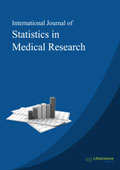ijsmr
Abstract: Data-Driven Longitudinal Model with Application to HIV Differentiated Care
|
|
Abstract: Background: Differentiated care is a new innovative approach for managing HIV/AIDS where ART treatment services are customized by staggering patients’ visits for stable status while reducing unnecessary burdens on the health system. Through provision of differentiated care, the health providers are able to reallocate resources and time to patients in who are failing treatment. Keywords: Differentiated care, HIV/AIDS, Generalized Linear Models (GLM), Generalized Estimating Equations (GEE), and Generalized Linear Mixed Models (GLMM). |
Abstract: Spatial Heterogeneity of Viral Suppression and Viral Rebound Patterns among ART Patients in Zimbabwe from 2004 to 2017: A Bayesian Mixed Effects Multistate Model
|
|
Abstract: Augmenting the global efforts towards HIV control and prevention, spatial modelling helps identify areas with poor viral suppression to inform programme planning. This study aims to describe the spatial viral suppression and viral rebound trajectories among ART patients. This is the first application of the fully Bayesian geoadditive semiparametric multistate Markov models to account for unobserved geographical heterogeneity. Time-varying log-baseline effects of the transition intensities and non-linear effects of continuous covariates were estimated as smoothed functions of time using penalised splines. Non-parametric effects of fixed covariates and frailty effects to account for individual variability were also considered. Viral load was the preferred marker for better prediction of HIV/AIDS disease progression; therefore, a three staged model was proposed bases on two viral load transient states defined by undetectable viral cut-off limits and death as the third absorbing state. Model application was based on the routinely collected individual-level data of ART patients from the Zimbabwe national ART programme. Amongst 18,150 participants, both the log-baseline transition rates of attaining undetectable viral suppression and attaining a viral rebound increased with increase in ART duration. Viral rebound transition was significantly prevalent among patients living on the long-distance truck route region (Matabeleland North province) which borders with Botswana and Zambia. Interventions which address health literacy and misconceptions over ART benefits and the gravity of attaining and sustaining viral suppression are a priority in the fight of HIV to increase patients’ life expectancy and lower HIV transmission. Keywords: Bayesian estimation, multistate Markov models, spatial heterogeneity, viral suppression, viral rebound. |
Abstract: Maximum Likelihood and Bayesian Estimation of Repeatability Index: Application of Estimating Ratio of Variance Components
|
|
Abstract: An index of repeatability is constructed to evaluate the relative magnitude of measurement error. This index is constructed as a ratio of two variance components. Estimation of the index is derived under the one-way random effects model. We compare the well-known maximum likelihood estimator to the Bayesian estimation procedure using non-informative prior. Large sample variance of the of the maximum likelihood estimator are obtained using the inverse of Fisher’s information matrix and the delta method. Inference procedure using the. We also construct a test statistic on the equality of two repeatability indices using the Monte Carlo integration and sampling Importance re-sampling method. We illustrate the methodologies on the estimation of the index of repeatability of Gamma-glutamyl-transferase, an enzyme found in many organs all over the human body, with the highest concentrations found in the liver. This enzyme’s level is raised in the blood in most diseases that cause damage to the liver or bile ducts and is considered an essential serum marker for alcohol-related liver disease. Keywords: One-way random effects model, Functions of variance components, Fisher’s information matrix, Gamma-glutamyl-transferase (GGT), Delta method, Jefferey’s priors, Monte-Carlo integration, Sampling Importance Resampling. |
Abstract: Adverse Event Risk Assessment on Patients Receiving Combination Antiretroviral Therapy in South Africa
|
|
Abstract: Purpose: To determine the risk factors for the development of serious adverse events (AEs) in black adult patients on combination antiretroviral therapy (cART). Keywords: Adverse events, cohort event monitoring, combination antiretroviral therapy, pharmacovigilance, risk factors, South Africa. |






















